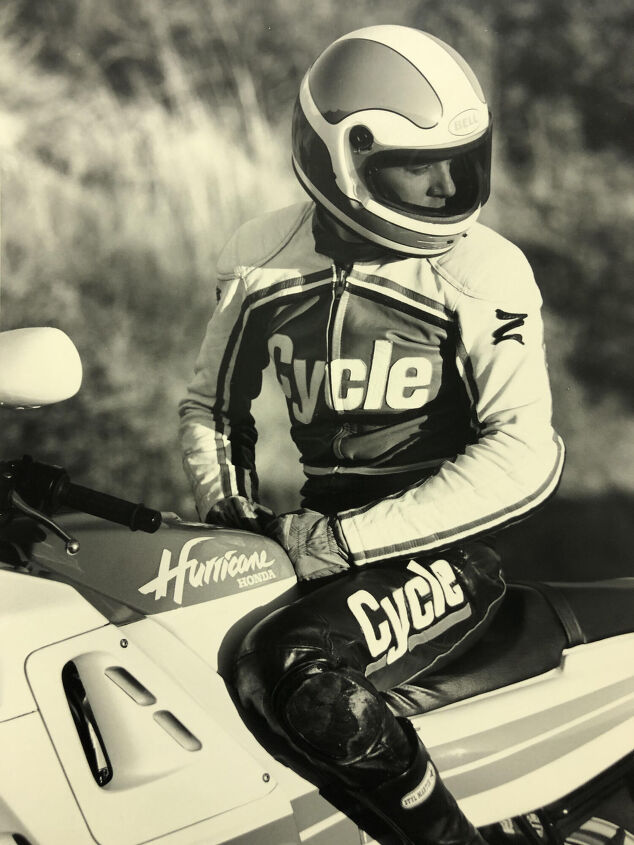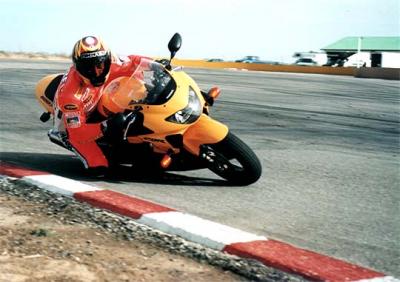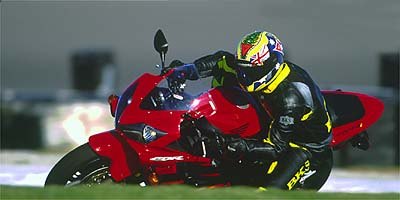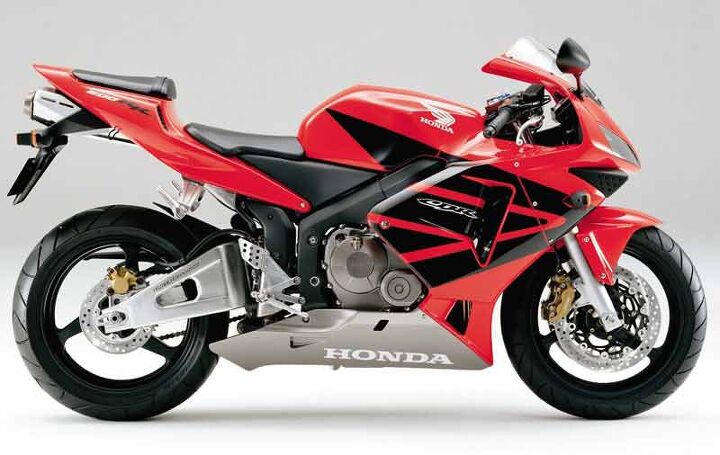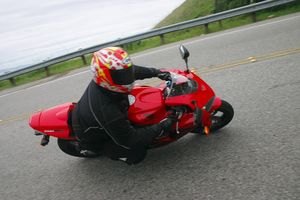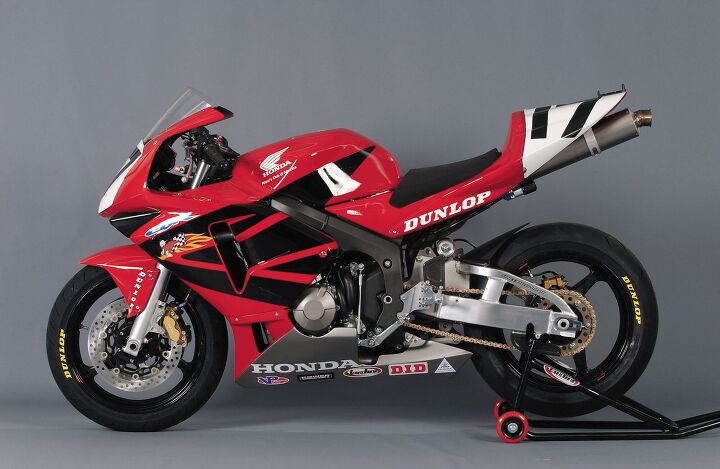Motorsports Racing News & Blog Articles
35 Years of Honda CBR600s: A Love Story
It’s happened. When I got into this business 30-some years ago, those who came before me were going on about Norton Commandos and BSA Gold Stars. I tried to fake it, but could form no mental picture of what they were even referring to? Are you sure you don’t have an earlybird special to get to or a nap to take? This year, the Honda CBR600 is 35 years old, and here am I to tell you all about probably the greatest motorcycle ever made. Strap in.
In 1986, sporty motorcycles were popular enough to advertise on TV – and that was when there were only three channels. I can’t remember if I saw the new 1987 CBR600 Hurricane first on the Motorola or on the cover of Cycle magazine when it appeared in the mailbox, but I do remember my heart skipping a few beats. Not only was this revolutionary Honda amazing looking and said to be amazing performing – at $3,698 it might even be affordable.
As long as I stayed enrolled in the U. of Mo, KC, a nice GI Bill check could also be depended upon to arrive monthly in the mailbox. Seems like my half of the rent was $135, tuition was pocket-change cheap, and I was also bringing down a whopping $8 an hour loading trucks part-time in a grocery distribution warehouse ($12 for any shift over 8 hours in that union shop)! Flush…
I don’t remember what it was about the new Hurricane that so grabbed my attention. Maybe it was the all-enclosing bodywork, which was said to be influenced by the Ducati Paso and other exotic Euro-bikes of the era, but really was a way of keeping costs down by not having to make the innards of the bike presentable. Probably it was just the claimed performance of the thing, at the real beginning of the middleweight performance wars – hence the Ninja commercial. But mostly because I was 26 years old and badly in need of speed and a testosterone outlet, with a few dollars to spare.
Also because in the years before Youtube, my monthly sportbike fix came from Cycle magazine, where they’d had a pair of CBRs to play with the last couple of issues. Ken Vreeke was there and remembers: “Yes, Honda provided two CBR600s to Cycle to go racing. The 600 class was heavily supported with contingency then, and very competitive. [Doug] Polen was traveling the country with a trailer full of CBRs and GSX-Rs and making a good living. Danny Coe [another Cycle deity at the time] sent his bike off a cliff on Latigo [there were pictures in the magazine!], and I took mine to the racetrack.”
Indeed. Somebody recently dug up this archival footage from 1987 of KV in action at beautiful Willow Springs, filmed on glorious VHS tape from the Budweiser Balcony.
Run-off room? We don’t need no steenkin’ run-off room… Kent Kunitsugu is in there somewhere too, I think he finished seventh-ish.
It was all too much to take; I drove to my local Honda dealer one early spring Saturday with cashwad in pocket, only to be told that every CBR600 Honda produced that year had already been sold. It was not the first of many vehicular tragedies I would suffer as a young man.
But I was actually happy enough to settle for a left-over ’86 VF500F for $2,749; it was that or a couple hundred more for a leftover bumblebee Yamaha RZ350, which is now collectible. Neither was a performance match for the new CBR, but both were a huge step up from the used junk I’d been abusing.
Astoundingly, it couldn’t have been much more than a year later that I had to sell the VF500, as I loaded up the Buick and moved to California to work at Cycle with my heroes. Pinch me. (Among the luminaries I would meet, besides Vreeke and Coe, is former Rider magazine Editor-in-Chief Mark Tuttle, whose dad wrote and produced “The Beverly Hillbillies.” I sang the theme song most of the way west.)
But enough about me. Right now we’re talking about the original Honda CBR600.
1987 Hurricane CBR600
The first Hurricane’s unique bodywork allowed designers to forego the usual engine and frame cosmetics, and instead devote development dollars to pure performance. The result was 83 horsepower from a liquid-cooled 16-valve inline-four, superb handling, and a claimed dry weight of 396.8 pounds – making the Hurricane the lightest, most powerful 600 available.
Coincidentally (or not), the Hurricane debuted the same year the AMA introduced its new 600 Supersport class. It won all nine races that year, making Doug Polen – who won seven in a row – the first AMA Supersport champion. In ’88, Polen signed a Yoshimura deal, jumped to a new Suzuki Katana 600 (lame), and won the championship even though the CBR won Daytona and six of nine races that season. Yamaha’s brand new FZR600 won the title in 1990 under the dearly and recently departed David Sadowski, which just shows how important and competitive the 600 supersport class was becoming.

1990 CBR600F. Note where the grips are in relation to the seat. Though it’s a “sportbike,” the early CBRs were remarkably humane.
To keep up, for 1990, the now no-longer called Hurricane CBR600F received engine revisions that yielded even more power: Revised porting and cam timing, recontoured pistons and combustion chambers, slightly higher compression ratio, recalibrated carb and ignition settings, and a new stainless steel exhaust system gave the CBR an additional 10 horsepower, Honda said.
I got to Cycle in I think 1989, and I don’t remember ever riding a CBR600F. But I definitely remember riding at least a few F2s, which Honda launched in 1991.
1991 CBR600F2
 Here’s what we wrote in a Top Twelve article a few years ago: “…when F became F2 in 1991, Honda’s plastic-covered middleweight morphed into one of the best all-rounders of all time – a near-perfectly balanced sportbike that won all the shootouts as well as the ’91 AMA 600 Supersport title under Miguel Duhamel.
Here’s what we wrote in a Top Twelve article a few years ago: “…when F became F2 in 1991, Honda’s plastic-covered middleweight morphed into one of the best all-rounders of all time – a near-perfectly balanced sportbike that won all the shootouts as well as the ’91 AMA 600 Supersport title under Miguel Duhamel.

Not only did MD win the Daytona Supersport race in ’91, he also won the 200, substituting for an injured Randy Renfrow on the Commonwealth RC30. (photo courtesy Honda)
A better companion than your dog, the F2 was also happy to be ridden on a daily basis or to San Francisco for the weekend. At the time, it was a “sportbike”; today we’d have to invent a new category, probably the ‘plastic-covered standard.’ All yours for $4,998.”
In fact, the CBR600 wasn’t just a great middleweight, it was a great motorcycle. We didn’t know at the time that the October 1991 issue would be the last Cycle magazine, but it was. The cover story was “World’s Greatest Sportbike,” in which the whole crew went for a nice multi-day ride comparing an F2 to a Ducati 900SS, a Kawasaki ZX-11, a Suzuki GSX-R750, a Yamaha FZR1000, and why not a Honda VFR750 too. Guess which one won?
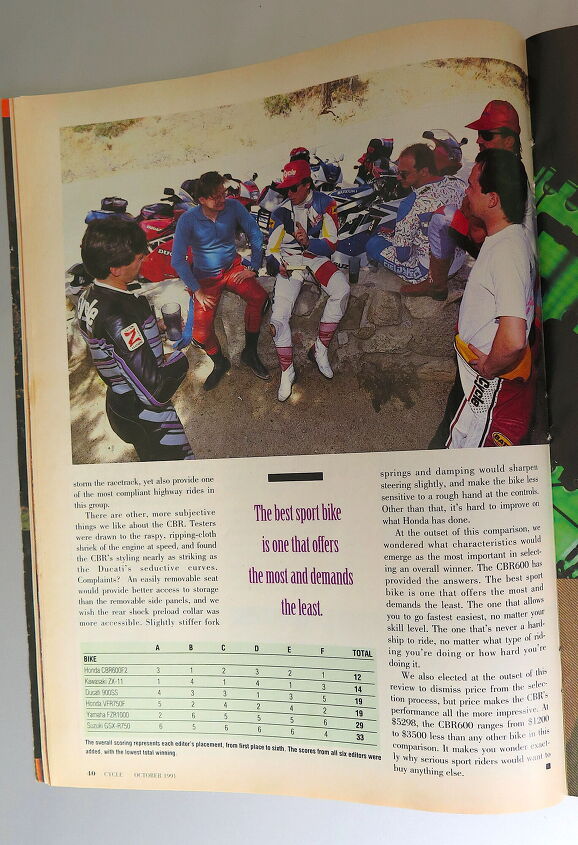
That’s me on the left when I was 50% as old as I am now, EiC Steve Anderson, Vreeke’s index finger, the late Charles Everitt, Thadeus Wolf, and T. van Hooydonk.
If you click on the pic it should blow up so you can get the gist of how the next to least-powerful and the least expensive bike ($5,298) beat all the others, after an 18-page extravaganza that included hot laps around the big track at Willow Springs. The CBR clocked a 1:35.84 to finish second, just 0.09 second off the fastest bike, the GSX-R750.

Pretty sure it was during the course of that test that the F2 encouraged me to drag knee for the first time ever… pretty sure I rode that F2 to Willow Springs and back, too. (Note perfect form and 30-year old thumbtack hole in vintage snapshot)
1995 CBR600F3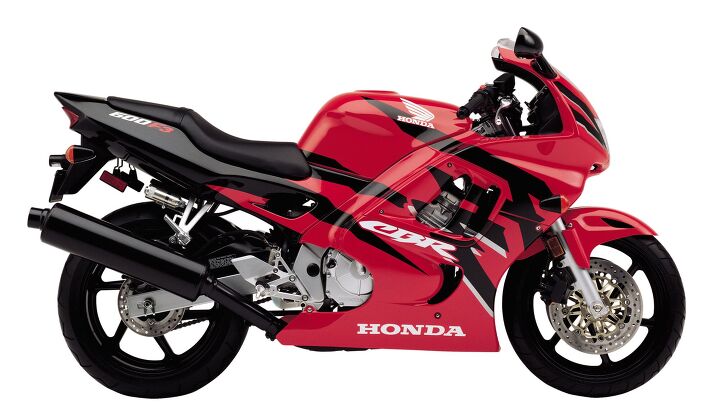
Ground-up redesign: compression ratio goes from 11.6:1 to 12:1 via more compact combustion chambers and new pistons. Low-friction piston rings, lighter connecting rods, smaller-diameter crankpins… curved radiator with increased capacity, new ignition unit with new-fangled throttle position sensor. Two-mm bigger, 36mm carburetors and shorter, straighter intake tracts fed by a dual-stage pressurized air-intake system are claimed to provide a major boost in performance at all speeds. Etc…
The new bike’s cartridge fork and fully adjustable shock get heavier spring and damping rates, with a more progressive ProLink linkage out back. Stiffer triple clamps and a larger-diameter swingarm pivot axle will deal with the bike’s 5-inch rear wheel. Cycle World reported an 11.05-second quarter-mile, and a 145-mph top end at 12,500 rpm.
But screw Cycle World. The F3’s coming-out party at Honda’s then not-so top secret facility in the desert (with 7-mile oval) was one of the first ones MO was invited to attend, just one year after its birth. Founding father Brent Plummer concluded:
In truth, we would have preferred a more RR-type update with upside-down forks and maybe 15 pounds less pork to lug around. But we certainly wouldn’t prefer to pay more than the manufacturer’s suggested retail price of $7,299 (that’s in US dollars). That’s a $900 price increase in one year! But the good news for value shoppers — which, as the dollar continues to drop against the yen, is just about all of us — is that the new 1995 CBR600F3 will give us the best of both worlds: Race-winning speed and technology coupled with good ergonomics, a friendly riding position, and Honda’s rock-solid reliability.
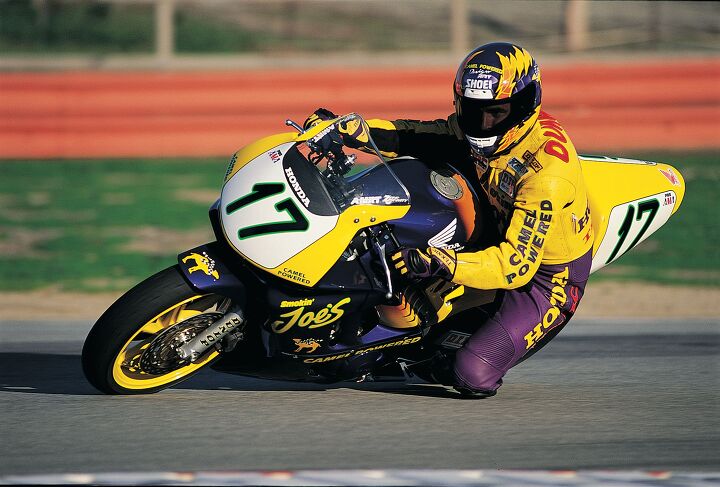
M. Duhamel wins his second 600 title on the new F3 in 1995 – all 11 races in fact, without even coming close to dragging his elbows. (photo courtesy of Honda)
For 1996, the F3 got new graphics and a $400 price bump. We still loved it, and concluded that year’s quick test with, The happy truth is that the F3 comes with one of the most comfortable peg/seat/bar relationships in the class. With all that going for it, it’s no wonder Honda chose not to mess with their best-selling bike in America.
I couldn’t remember if I’d been just imagining that, but I think it’s correct: For more than a year or two, Honda said the CBR600 was its #1 seller. I wonder if now its best-seller is still the Grom? What a barometer for how things have changed, and not in a good way. 1995 was also the year Timothy McVeigh blew up the Oklahoma City federal building and OJ was found not guilty.
1999 CBR600F4
 In early ’99, then, it was time for another 600 Supersport Shootout starring Roland Sands, Chuck Graves, et al, and an all-new Yamaha YZF-R6… guess who won?
In early ’99, then, it was time for another 600 Supersport Shootout starring Roland Sands, Chuck Graves, et al, and an all-new Yamaha YZF-R6… guess who won?
“The battle for 600 Supersport supremacy boiled down to a choice between raw attitude versus refined balance. While attitude carries more pop currency, balance should not be ignored.
What Honda achieved with the CBR600F4 is nothing short of remarkable, creating a high-performance 600 supersport capable of winning Championships while not sacrificing the comfort and versatility that made its predecessor the top selling sportbike in the world. It should also be noted that while Kawasaki, Suzuki and Yamaha produce other, more-street oriented 600s, Honda chose to make only one 600.
To do what Honda did – design a motorcycle that in many circumstances will outperform other OEM’s race-replica supersports yet remain as comfortable and easy-to-ride as the competition’s street-oriented 600s – should not be underestimated. Perhaps no other manufacturer could pull this off.
If you take delivery of a stock CBR600F4 with the suspension set at stock and ride home down the freeway, you’ll swear you were on a plush sport tourer. When you’re home, crank on the very accessible and easily adjustable spring, preload and compression and you’ll have a super-fast, super-tight, aggressive canyon scratcher.
The F4 is light: at 428 pounds wet, only the R6 is lighter. The versatility of the F4 is amazing: This is a bike that can be enjoyed equally by both the expert card holder and the intermediate rider fresh from track school.
2001 CBR600F4i
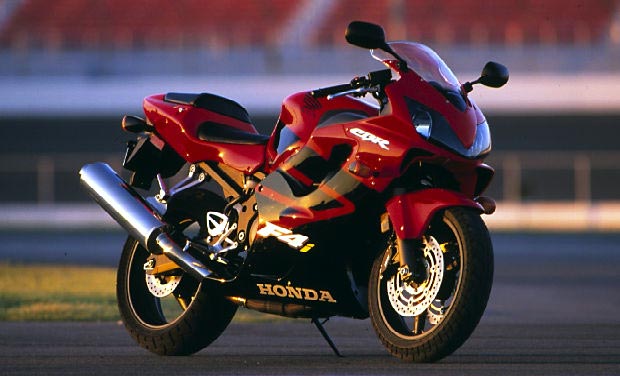
The unobtrusive “i” appendix marks the end of an era and of the ubiquitous carburetor, and the adaptation of Honda’s PGM-FI programmed fuel injection – a thing that had to be done in the face of tightening emissions standards. A single four-hole injector per 38mm throttle body provides a more efficient burn, with the California model meeting CARB 2004 through the use of a catalyzer that drops two peak horsepower. There’s also a 5.9%-more rigid frame now painted black, under a slipperier new fairing, a bigger airbox, and a bunch of other subtle tweaks Honda lavished upon its favorite money maker. Out of habit, Duhamel won the Daytona Supersport race on the new bike.
It wasn’t the first year the CBR didn’t win MO’s somewhat annual Supersport Shootout; it still finished a close second to that year’s R6, which was also really quite comfy but slightly racier than the Honda.
Of the CBR, MO said: This is by far the best streetbike here, thanks to comfortable ergos and a motor that doles out easy-to-use power everywhere. The suspension’s also extremely plush while maintaining enough firmness that, should the pace quicken, it’s all in a day’s work for the little CBR. The rider’s information display is also the most comprehensive in this test while maintaining the sort of ease-of-use that gives you just what you need in a quick glance without becoming too cluttered.
Not unexpectedly, the Honda’s downfall is the race track where it’s not as solid as the other bikes are. Still, it only took a few clicks and twists to get the bobbing and weaving bike to settle on its haunches and get back into the swing of things.
Oh yeah? Too streetbikey for ya huh? In the depths of our kneepuck addiction, when all the OEMs kept feeding us ever-sportier sportbikes and a steady diet of track days, we only craved more. Push the powerband higher, make me bend over further! I want to be like Valentino! No pain, no gain used to be a popular saying before they blew up the World Trade Center.
2003 CBR600RR
Okay, If you’re sure that’s what you want, said Honda in 2003, as it dropped the “F” and bombed us with the CBR600RR, which was packed with RC211V MotoGP technology. That bike and its V-Five engine and Valentino Rossi had already laid waste to the 2002 MotoGP championship, and was about to do it again in 2003 and ’04.
The new RR was as the name implies: Really racy. Actually Honda kept building the F4i through 2006, but guess which 600 everybody wanted?
As near as I can tell, MO didn’t do another 600 Supersport comparison until 2005. By then I was in a dank cubicle in Palookaville, but Sean Alexander was in charge and the Yamaha R6 came out on top that year.
“It’s [the R6] is the best street bike because its riding position is immediately comfortable and feels the most natural,” says Sean. Our street and everyday riding tests revealed some unexpected strengths and weaknesses. Who would’ve thought the compact Yamaha R6 to have the most comfortable riding position? Who would expect a Suzuki GSX-R to offer ergonomics that fit everybody? Who would believe that last year’s torture rack ZX-6R could transform into this year’s living room couch? Would you believe that a Honda finished a distant fourth in our comfort rankings? It’s all true.
No! I would not have!
After testing the new CBR600RR at Buttonwillow Raceway, Sean named it the best-handling sportbike he’d ever ridden. On the street however, the CBR’s stellar handling wasn’t enough to overcome the weight it places on the rider’s wrists, its hard seat or its buzzy engine. The Honda is a racebike and it seems best to leave the street duties to the other three. A good deal farther up the practicality and comfort scales, you’ll find Suzuki’s GSX-R 600.
That’s right, a Suzuki GSX-R was a good deal farther up the scales in comfort and practicality. All that RC trickle-down meant the CBR did win the track portion of that year’s test, but our jack of all trades, and master of most CBR, was no more. The next year, 2006, Yamaha blew up its sweet-spot R6 for a much racier, peakier new model that followed in the CBR-RR’s wheel tracks, and would be the final R6. (The R6 right before Yamaha went terminally racy was delectable.)
A year or two later, the Great Recession hit. People quit buying all kinds of motorcycles, but it seems they especially quit buying 600 Supersports. Here today, gone tomorrow.
You can blame the economy, you can blame the government (whose tightening emissions laws are particularly hard on high-revving powerful small engines), but most of the blame probably falls to all us Boomers for growing old en masse and sucking along most of the national wealth in our wake. A lot of us still love roadracing, but really it’s no sport for old men. Much of the blame must go to Honda and Yamaha, who should have known better than to give us exactly what we asked for – racebikes for the street – as their MotoGP addiction seeped into the rest of the plant. Then again, Kawasaki and Suzuki’s 600s never grew as extreme, and their sales fell off too.
Anyway, yesterday’s pimply squid is today’s stretch-pants adventure rider, no? Things change in unpredictable ways. Though Honda hasn’t changed that original 2003 RR much at all in the ensuing 19 years, some of us are left wondering what CBR600F7, 8, or 9 might’ve been like? Nothing like the 1987 Hurricane, probably. More like a 110-horsepower F4i with modern electronics in a less-extreme 400-pound package? Alas, you can’t go home again can you? Let’s just remember the happy times. Right now I’ve got a siesta to take, and an earlybird special to hit. Happy 35th, old CBR.






Become a Motorcycle.com insider. Get the latest motorcycle news first by subscribing to our newsletter here.
The post 35 Years of Honda CBR600s: A Love Story appeared first on Motorcycle.com.
Copyright
© Motorcycle.com


